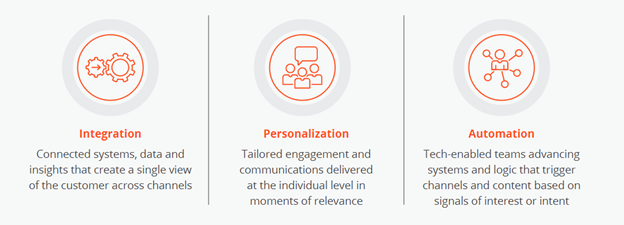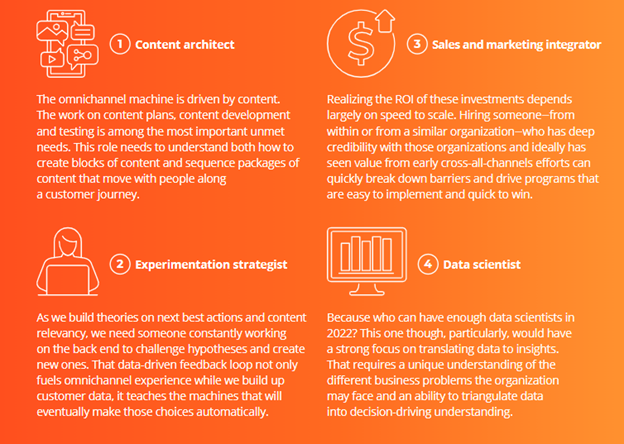Personal, Tailored and Now Possible: 2022 Health Trends
2022 Health Trends
According to a benchmarking study by Syneos Health, biopharma leaders on average rate their use of modern customer engagement and omnichannel infrastructure at six out of ten, notably better than prior to the pandemic. The year ahead will bring new work in building both capability and scale, ultimately enabling better experiences for both customer and business. But, importantly, the transformation has more than begun. For many companies, this evolution wasn’t an easy or perfectly executed one. Instead, the pressure of immediate change left man
teams scrambling to quickly get to basic viability in new systems and ways of working. Just who those teams were varied by organization. Some were quickly integrating new technologies while others were learning how to use new engagement models in which they lacked direct experience. As we move from a six to a seven, from reacting to a crisis to establishing a new consistent approach to customer engagement, we’ll increasingly focus on transformation around three key elements of omnichannel: integration, personalization and automation. Each working together to offer a better customer experience with more relevance, more convenience, more value.

WEBINAR: Sustainable Acceleration Throughout the Product Lifecyle
This year, the industry is focused on four key areas of omnichannel growth.
1. Leadership commitment and organizational change
Omnichannel is moving from a marketing initiative or IT infrastructure project to a core strategic capability. That elevation is giving it access to speed, scale and resourcing.
Look for leadership on two primary aspects of omnichannel: ROI modeling within larger enterprise strategy and change management as modern customer engagement initiatives need to move quickly from bold brand pilot to the very edge of the organization to maximize impact. Without the ROI analysis, executives fear Leadership will go back to the old way of doing things and fail to maintain investment in omnichannel.
The goals in change management will be to introduce agility into clinical development, medical affairs, marketing, sales, market access, commercial operations and technology teams and bring the sources of insight (data) much closer to the points of execution.
Workstreams are likely to include alignment and cascading of a shared vision, capability building within individual teams and with partners, aligning on new roles and interdependencies, and extensive change management.
Omnichannel will likely continue to require centers of excellence within large pharma through at least 2024 to focus on building a strong foundation. These internal centers are evaluating technology, setting policies and processes for partners to integrate data and codify new ways of work. They help individual teams perform with confidence, actively communicating success stories to lead the change.
3. Foundational 360° view of customer
While the industry conversation right now is focused on artificial intelligence and next best actions, the rollout of those is likely to be highly targeted in 2022. You’ll see next best actions built on carefully crafted "recipes" based on a strategic understanding of digital behavior, meaning, customer action X should be followed by brand action Y.
That logic can be quickly automated in systems as either triggers or direct 1:1 customer engagement. To fuel the machine learning needed to continue to build omnichannel maturity, organizations will invest in building a critical foundational element in 2022: a unified, 360-degree view of each customer. That investment is one way data becomes pervasive in an organization and ultimately fuels differential resourcing and decision making by artificial intelligence.
Importantly, the centers of excellence also track a full executional roadmap across brands to create transparency about how tools and systems are being used and also identify new capabilities that will be required to reach brand ambitions far in advance of project start. Yet, while the centers can help organizations in many ways, they can also hurt by creating silos. To avoid this, the centers must have decision-making authority, a seat at the table with other commercial leaders so their recommendations are pulled through, not pushed aside.
2. Tightening alignment between sales and marketing
The roles of sales and marketing are always evolving and changing in biopharma. The hallmark of 2022 will be more closely uniting them around both customer insight and omnichannel activation.
In the benchmarking report mentioned above, we found that most biopharma is defining omnichannel as every channel except the field. Leaving the field—our highest impact channel—out of omnichannel misses a great deal of the opportunity in letting insights and triggers flow across channels.
In 2022, look for field teams to expand their depth and reach into call lists with automated, 1:1 digital messaging that alerts them when an account or healthcare professional shows a signal of digital interest. Expect programs that leverage CRM data to reinforce specific rep-healthcare professional conversations in a wide range of digital media. From the beginning, sales leaders must work with marketing on omnichannel design and implementation—rather than issuing requests for sales to execute. Marketing must supply the “why” behind the initiatives, what it means to reps and their customers.
4. Contingent content
The promise of modern marketing is right person, right moment, right message. That last part‒well, that’s a tricky one for biopharma. A typical consumer campaign might include 500 or more pieces of content that could be dynamically adapted, responding automatically to different customer attributes, behaviors and context.
That’s a different type of content than traditional pharmaceutical communications. Instead of a small number of rigorously approved assets, it demands a much greater number of modular content pieces that can be combined and connected based on business rules and data.
In 2022, biopharma companies will work to adapt systems to consider how to develop, approve, archive and activate motivating, personal content at speed and scale‒they know this is lacking. Content will need to be modular to respond to individual journeys and signals of interest which will open up new conversations about the processes and possibilities of approving content sets based on if/then scenarios vs. final art.
“The roles of sales and marketing are always evolving and changing in biopharma.”
Accelerating Clinical Trial Recruitment: A New Path to Speed Enrollment
Critical Roles for 2022
We invited our commercial leaders and our omnichannel centers of excellence in the US and Europe to take the perspective of omnichannel leadership at a mid-sized biopharma company and imagine the key hires they would make this year to realize the goals and ambitions our industry has for modern stakeholder engagement. Here’s the lineup:

KEYNOTE: Omnichannel Engagement in the New Commercial Model
Ideation Tool:
Focus on Personal, Tailored and Now Possible
Question Burst
One day, Hal Gregersen, Senior Lecturer in Leadership and Innovation at MIT, was running a brainstorming session with his class that he said felt like “wading through oatmeal.33” They’d discussed the issue at hand but weren’t getting to new ideas and the energy level for innovation was waning. So, he shifted the focus. He said, “Let’s forget about finding answers for today and just come up with some new questions we could be asking about this problem.”
He asked the class:
simply generate questions.
This incredibly valuable exercise energizes thinking, helps to prioritize what we’d need to know to move forward and even challenges basic assumptions that may be limiting thinking.
Give it a try
if you’re working on your own, simply start listing questions you have about omnichannel engagement that we covered. What do you want to know?
Then prioritize three to four questions that would help inform your thinking. How will you get those answers?
If you’re working in a group, pick a topic. Invite people to spend a few minutes writing down their own questions, then share around the group, ultimately clustering and prioritizing the few you most urgently need answers to.
How Pharmaceutical Marketers Can Put the Human Back into Digital



